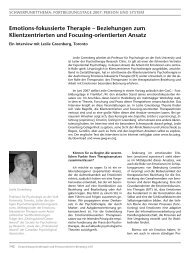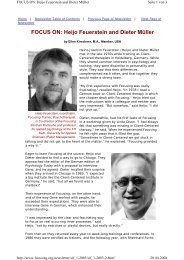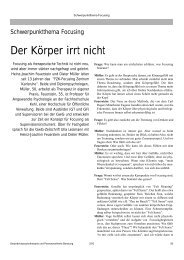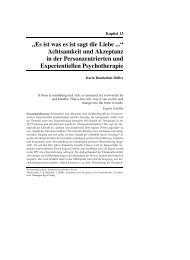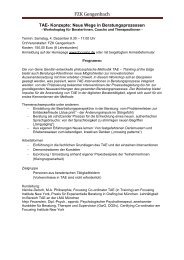Body-oriented interventions… - FOCUSING
Body-oriented interventions… - FOCUSING
Body-oriented interventions… - FOCUSING
You also want an ePaper? Increase the reach of your titles
YUMPU automatically turns print PDFs into web optimized ePapers that Google loves.
Leijssen M., Nagels A. & Dekeyser M.: <strong>Body</strong>-<strong>oriented</strong> interventions in psychotherapy.<br />
refer to body-<strong>oriented</strong> behaviour. The resulting observations imply three perspectives:<br />
personal experience, verbal communication and nonverbal interaction. “What words refer to<br />
someone’s body?” turns out to be a central question for both the discussion and the<br />
research of body-<strong>oriented</strong> interventions.<br />
3.1 Introduction<br />
The concept of a body-<strong>oriented</strong> intervention is usually typified by examples. This concept is<br />
rarely demarcated formally and the examples most often serve as an illustration of a<br />
particular account of psychotherapy. First I will attempt to define the body-<strong>oriented</strong><br />
intervention in terms neutral to various theories of psychotherapy. Next I will show how this<br />
demarcation allows for the empirical study of body-<strong>oriented</strong> interventions, independent of<br />
therapeutic orientation.<br />
Transcript 1: <strong>Body</strong>-<strong>oriented</strong> behaviour in a fictitious therapeutic session<br />
C: You tell me to go ahead and talk about this problem. But where shall I start?<br />
C waves hands.<br />
C really has no clue.<br />
T imitates C’s hand movements while listening.<br />
T gets a sense of disorientation from the movements.<br />
T: Look at how you wave your hands. You really don’t know where to start.<br />
T repeats and exaggerates C’s hand movements.<br />
3.2 Definition<br />
<strong>Body</strong>-<strong>oriented</strong> behaviour – exemplified in<br />
Transcript – is any behaviour that directs the attention of the client or the therapist to either<br />
person’s body or their bodily interaction. I would like to include in this category all behaviour<br />
that one assumes to direct the client’s or therapist’s attention.<br />
I use the word intervention in it’s broadest possible sense – the act of influencing a process<br />
– applied to the context of a therapeutic session. An intervention is a type of behaviour that<br />
is performed by a therapist in a therapeutic session. The term includes behaviour in the<br />
sense of verbal statements, nonverbal style, incidental gestures, unconscious changes in<br />
posture, etc. The influenced process can be the client’s process, the therapist’s process, the<br />
process of their mutual interaction or the process of any ongoing interaction for that matter.<br />
Whether some therapist behaviour can be considered as an intervention is to be decided by<br />
the therapeutic practice. Note that this definition of an intervention allows for the initial<br />
inclusion of all therapist behaviour as a candidate for the title of “body-<strong>oriented</strong><br />
intervention”. For the present, a body-<strong>oriented</strong> intervention is any body-<strong>oriented</strong> behaviour<br />
performed by a therapist.<br />
© 2003, Leijssen, Nagels & Dekeyser (U. Leuven, Belgium)<br />
Proceedings of the 15th International Focusing Conference 2003 Pforzheim/Germany, ed. by HJ Feuerstein,<br />
FZK Verlag, Weingarten (Baden), Germany<br />
6




